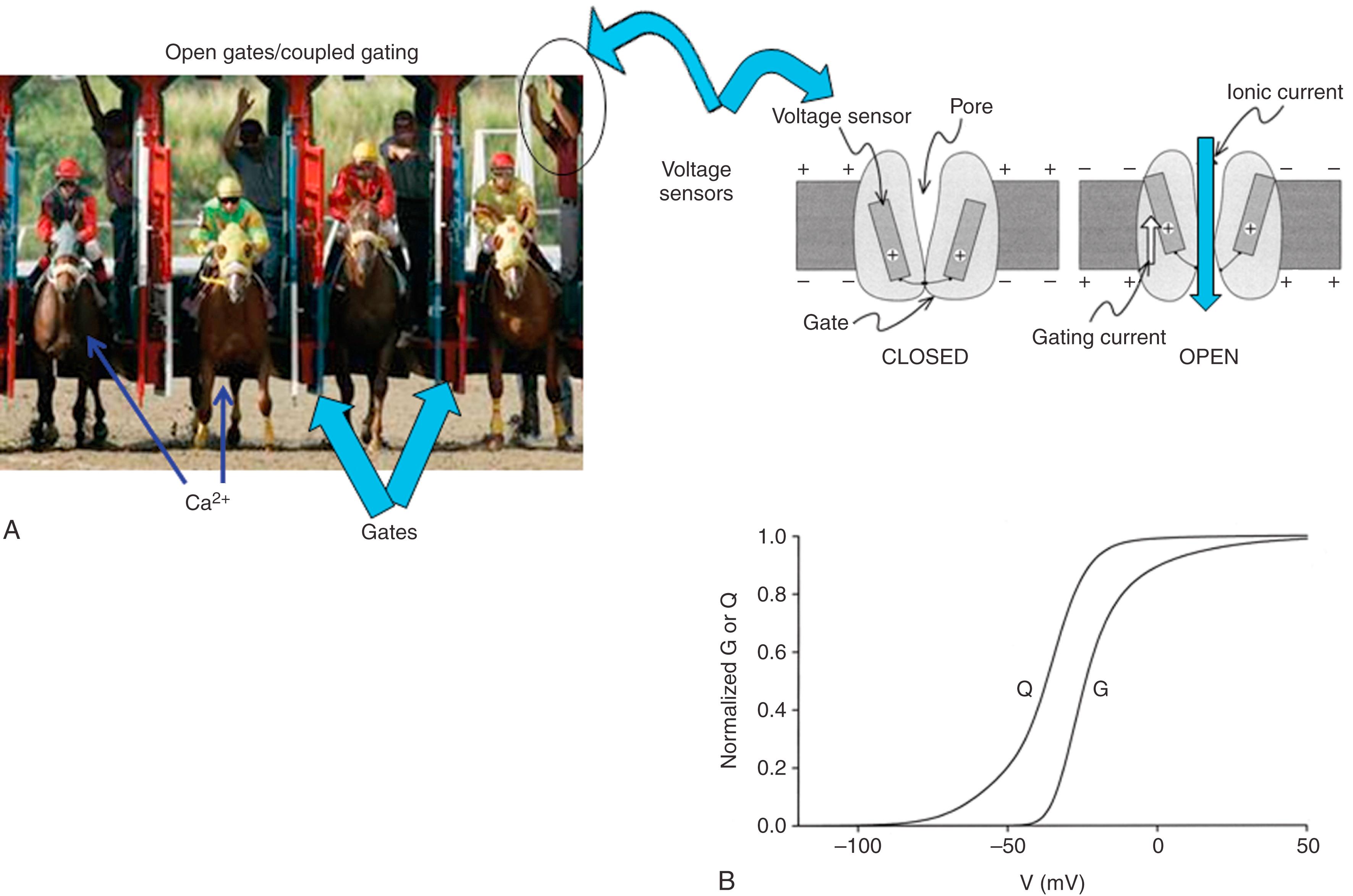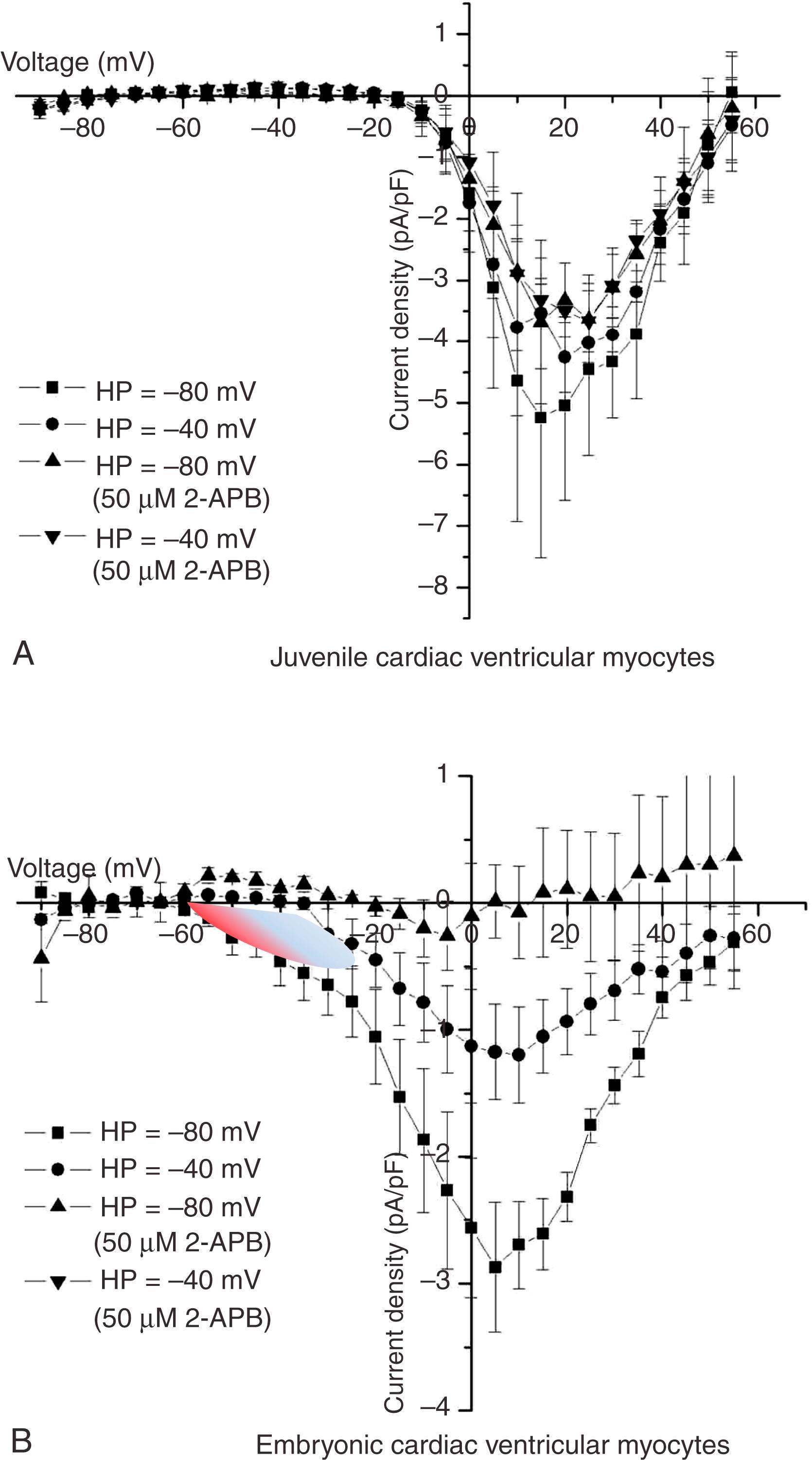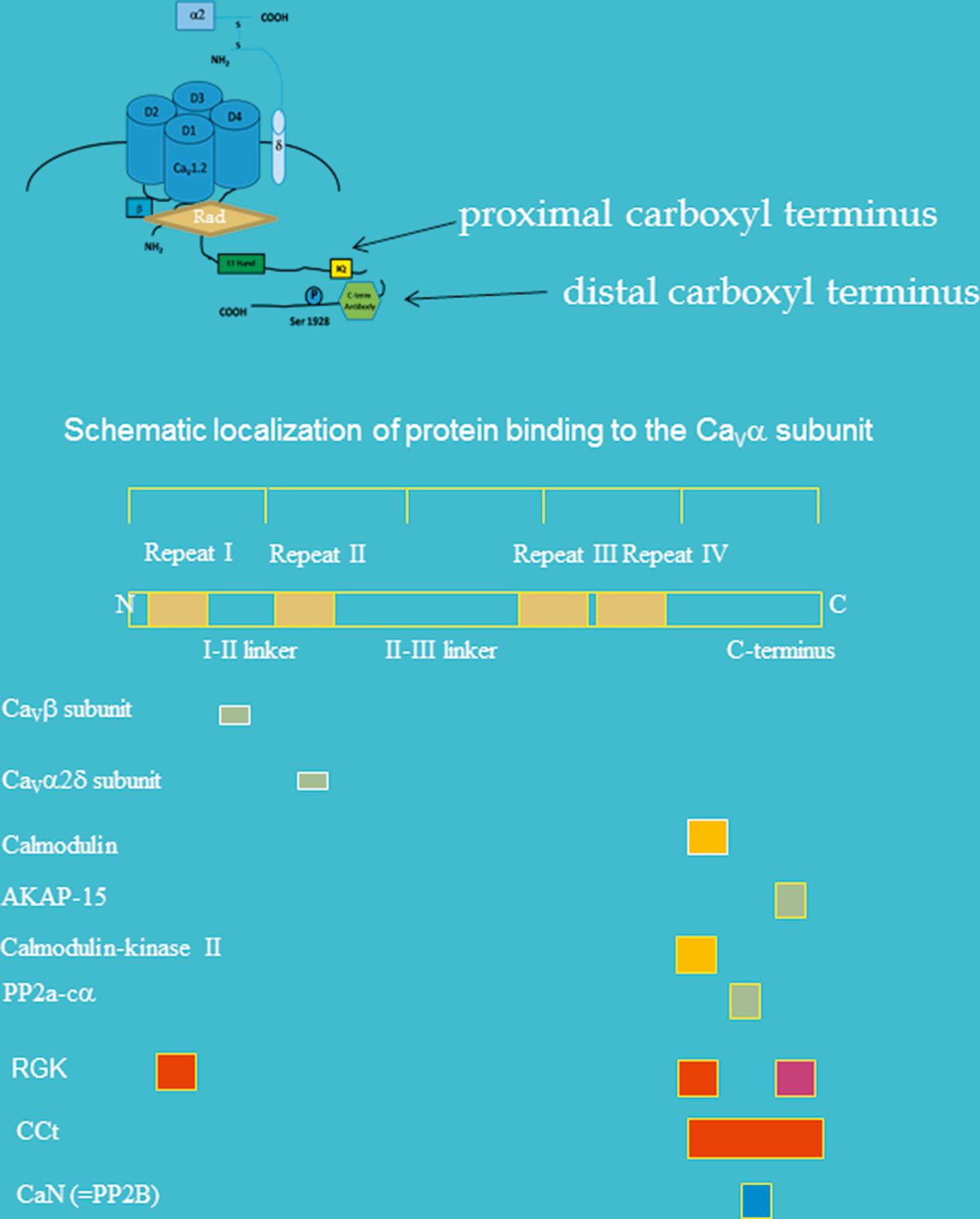Physical Address
304 North Cardinal St.
Dorchester Center, MA 02124
The superfamily of voltage-gated ion channels is defined by the common ability of the protein to sense transmembrane potential. Voltage-gated ion channels, specifically voltage-gated cation channels, consist of a pore-forming protein (the α-subunit) that shares the general structural plan consisting of six α-helical transmembrane segments and a region of amino acids between transmembrane segments five and six (S5 and S6) that fold from the extracellular space in toward the cytosol to form the outer permeation pathway. The fundamental common property of voltage sensing is conferred by a transmembrane α-helical stretch of amino acids in the fourth transmembrane segment, S4. But gating is not simply movement of S4 segments. This chapter describes the regulation of cardiac calcium channel gating. For outstanding resources for ion channel biophysics, the reader is directed to classic textbooks by B. Hille and L. Defelice.
Voltage-gated Ca 2+ channels tend to open in response to depolarization and tend to close after repolarization. A channel transiting from an open to a closed state is summarized as activation gating. Channel gating can be envisioned as a mechanical contraption that allows ionic flow across a barrier ( Fig. 10.1 ). It requires some imagination to picture a complex molecule undergoing gating. Consider a starting gate for the Kentucky Derby horse race. In this picture the motionless horse represents the potential energy of a calcium ion affected by its electrochemical gradient. Once the gate opens the calcium ion flows down its electrochemical gradient. Although the ion may interact with the gate, and influence the gate, the gate is operated independently. Moreover, there are a series of sequential complex steps between the starter pushing the button for the gates to open and the actual gating event. Similarly, initial movement of the voltage-sensing domains (charged S4 segments) in response to voltage is transmitted in a complex, incompletely understood fashion to other domains of the channel that alter the permeation pathway allowing ionic flux.

Cardiac L-type Ca 2+ channel gating is influenced by voltage, Ca 2+ -ion, posttranslational modifications, and protein-protein interactions. Voltage is a major determinant of gating, and one must also consider superimposed effects of permeating cations and modulation of gating primarily by channel phosphorylation status. Finally, the cardiac calcium channel is a heteromultimeric protein complex. Accessory proteins and interacting proteins, either directly or via scaffolding proteins, modify cardiac calcium channel gating. Additional details on the L-type Ca 2+ channel in the heart are found in Chapter 2 , the focus on excitation-contraction coupling is covered in Chapter 16, Chapter 6 , and β-adrenergic regulation of cardiac function in Chapter 41 .
The myocardium expresses L-type and T-type voltage-gated calcium channels. Myocardial L-type calcium channels (LTCC) include Ca V 1.2 and Ca V 1.3. Mature ventricular myocardium almost exclusively expresses the Ca V 1.2 channel. Ca V 1.2 and Ca V 1.3 are expressed in atrial cardiomyocytes, and Ca V 1.3 is also expressed by sinoatrial and atrioventricular nodal cells. Commensurate with these tissue localizations, Ca V 1.2 is critically important for providing trigger calcium for excitation-contraction coupling, and Ca V 1.3 contributes to heart rate and cardiac conduction. , In the ventricular myocardium there is an age- and gender-dependent gradient of I Ca,L . Prepubertal males have elevated I Ca,L at the base of the heart, but developing females do not. In adult rabbits, the gradients are somewhat reversed, with females displaying higher I Ca,L at the base compared with males. This may be related to estrogen regulation of L-type Ca 2+ gene transcription.
T-type Ca 2+ channels in the heart are encoded by Ca V 3.1 and Ca V 3.2 pore-forming subunits. , T-type Ca 2+ current, I Ca,T , is not normally observed in the mature mammalian ventricular myocardium. I Ca,T is present in pacemaker cells, atrial cells, and Purkinje fibers. I Ca,T is also expressed in developing cardiomyocytes. , , Consistent with the adage that pathologic cardiac hypertrophy is accompanied by reexpression of the fetal gene program, I Ca,T is reexpressed in ventricular hypertrophy of cat and rat.
The gating properties of I Ca,T versus I Ca,L are fundamentally distinct. T-type versus L-type channels are also classified as low-voltage activated versus high-voltage activated, respectively. The activation of the range of I Ca,T is positive to about −60 mV, whereas I Ca,L activates positive to about −20 mV. Closed-state inactivation also follows a similar general pattern. T-type Ca 2+ channel steady-state availability is maximal for voltages less than −90 mV, whereas substantial closed-state L-type channel inactivation is not observed for potentials as positive as approximately −40 mV. The positive shift of I Ca,L availability (also known as steady-state inactivation) has a practical benefit for measuring ionic current in ventricular cardiomyocytes as well. Voltage-gated Na + channels are largely inactivated at −40 mV, thus a prepulse to −40 mV is frequently used to isolate I Ca,L from prominent overlapping I Na . An alternative method used to measure I Ca,L in ventricular cardiomyocytes is to replace external Na + with an impermeant cation. I Ca,L can then be measured using more negative holding potentials. In juvenile ventricular cardiomyocytes hyperpolarizing the holding potential from −40 to −80 mV has only minor effects on peak I Ca,L ( Fig. 10.2A ). In contrast, embryonic ventricular cardiomyocytes exhibit I Ca,T and I Ca,L . I Ca,T manifests itself as a current activating positive to −60 mV when a −80 mV holding potential is used, and this low-voltage activated Ca 2+ current (I Ca,T ) is closed-state inactivated by holding the potential at −40 mV (see Fig. 10.2B ). Heterologous expression systems transfected with pore-forming Ca V 3.x subunits alone reconstitute most of the native I Ca,T properties. In sharp contrast, native I Ca,L gating requires auxiliary proteins, and in some cases it is rather difficult to completely recreate in heterologous expression systems. The remainder of this chapter focuses on Ca V 1.2, the predominant L-type Ca 2+ channel.

The pore-forming Ca V 1.2 Ca 2+ channel does not gate in isolation in cardiac myocytes, and studies of ionic current in heterologous expression systems show that a functional ion channel complex requires auxiliary proteins. Although the total number of Ca V 1.2-interacting proteins is unknown, several important interacting partners have been identified and studied ( Fig. 10.3 ). Early electrophysiologic studies in nonexcitable cells heterologously expressing Ca V 1.2 alone showed little, if any, discernable ionic current. Coexpression of Ca V β-subunits is a requirement to study L-type Ca current from channels generated by plasmids introduced into nonexcitable cells. Ca V β–Ca V 1.2 interactions occur via a deep hydrophobic pocket of Ca V β complexed with the L I-II domain of Ca V 1.2. Ca V β-Ca V 1.2 interactions have gating and nongating consequences. Ca V β-Ca V 1.2 binding influences a Ca V 1.2 carboxyl-terminal rearrangement to promote surface expression. Despite the relatively high-affinity Ca V 1.2-Ca V β interaction (2–54 nM), dynamic Ca V β-Ca V 1.2 interaction may also occur with respect to L-type Ca 2+ channel gating , consistent with the idea that Ca V β modifies Ca V 1.2 function in a complicated, regulated fashion.

The Ca V 1.2 carboxyl terminus spans approximately 300 amino acids (size differing among splice variants), from the cytosolic border of homologous repeat IV transmembrane S6 until the termination of the protein. The distal carboxyl terminus is proteolytically cleaved yielding an approximate 37 kDa protein that covalently reassociates with the proximal carboxyl terminus to regulate function (see Hulme and associates and also see later). The distal carboxyl terminus also can localize to the nucleus where it regulates gene transcription, including that for Ca V 1.2. The proximal carboxyl terminus remains contiguous with the pore-forming Ca V 1.2. Calmodulin (CaM) is prebound to Ca V 1.2 on the proximal carboxyl terminus in the IQ motif , and is a critical determinant of Ca 2+ -dependent inactivation (CDI) gating (see later). IQ is the abbreviation for isoleucine and glutamine. The “I” of the IQ motif is essential for CaM binding, , and mutation of isoleucine of the IQ motif induces dilated cardiomyopathy and premature death. Two CaM molecules interact with the proximal carboxyl terminus of Ca V 1.2, and the CaM molecules on Ca V 1.2 are arranged in an antiparallel fashion. , The proximal carboxyl terminus of Ca V 1.2 also interacts with several other proteins that modify channel gating. The monomeric G protein Rem functionally competes with CaM for channel regulation at this domain as well. CaM-kinase II (CaMKII) tethers to the proximal carboxyl terminus and is an important modulator of Ca V 1.2 activity.
CaM and Ca V β-subunits have received most of the early attention as key regulatory subunits. Ongoing and recent studies highlight the RGK family of proteins, in particular the protein Rad, as a critical governor of LTCC function , (see later). At present it is unclear how many proteins combine to form the native LTCC complex. An unbiased proteomics screen of the closely related N-type calcium channel Ca V 2.2 revealed channel interactions with 207 proteins. Thus multiple protein-protein interactions sum yielding native I Ca,L properties. In fact, the number of interacting proteins for the Ca V 1.2 carboxyl-terminal domain exceeds the restricted space, suggesting that weak protein-protein interactions among multiple proteins creates the possibility of diverse mixtures of proteins for any given L-type Ca 2+ channel complex. Some of the known Ca V 1.2 interacting proteins are summarized in Table 10.1 .
| Protein | Association Site/Interaction Domain on Ca V 1.2 | Reference |
|---|---|---|
| Ca V 1.2 | DCT; N-terminus | |
| Ca V β 2 | L I-II ; PCT | |
| Ca V 1.2–DCT | PCT | |
| α2 δ | Uncertain | |
| Calmodulin (CaM) | IQ motif of PCT | See text |
| Calmodulin kinase II (CaMKII) | PCT | |
| Rem | Via Ca V β2; DCT; N-terminus | |
| Rad | Via Ca V β2; C-terminus | , |
| Calcineurin (CaN = PP2B) | DCT | , |
| PP2A | DCT | |
| PDE4B | Ca V 1.2 by ip, no subdomain determined | |
| Akap150/79 | PCT–DCT scaffolds with other proteins | |
| PKA | PCT–DCT via akap | |
| α -Actinin | PCT/DCT | |
| Sorcin | PCT |
The defining functional feature of the superfamily of voltage-gated ion channels is the conserved property that depolarization tends to open channels. The process of opening can be summarized by the term activation. According to classical ion channel biophysics, Ca V activation is a smooth curvilinear function of voltage described by one or more Boltzmann distributions. Conversely, repolarization closes (deactivates) channels. Deactivation gating is distinguished from inactivation gating. Deactivation relates to a rapid, reversible transition between an ion-conducting channel conformation and a nonconducting conformation. Inactivation is a longer-lasting nonconducting conformation that may be influenced by the position of the voltage sensors. As with the closely related Na V channel family, Ca V channels contain four S4 segments that presumably displace toward the extracellular space on depolarization. This S4 displacement then drives allosteric rearrangements resulting in an increase of channel conductance. Collectively the depolarization-dependent increase of channel conductance is referred to as activation gating.
Ca V 1.2 S4 segments each contain 4 to 8 positive-charged amino acid residues (lysine [Lys] or arginine [Arg]) in register. Thus when the transmembrane potential (Vm) is negative, the S4 positive charges are electrostatically drawn toward the cytosol. Conversely, depolarization results in relative motion of S4 charges toward the extracellular space. The movement of charge across an electric field creates a current. If no ionic flux occurs, and a depolarization is applied, S4 segments will move, generating what is commonly called a gating current. To measure Ca V 1.2 gating currents, channel blockade is applied, or voltage is clamped to the reversal potential of the channel resulting in no net ionic flux. It should be noted that gating current yields information of the number of active channels, and the movement of the S4 segments, but gives incomplete information for activation gating. To reiterate, activation gating begins with voltage sensing (measured as gating current). Subsequent allosteric channel rearrangements result in activation gating. Gating current normalized to ionic current in a given cell is a measure of coupling between voltage sensing and allosteric rearrangements resulting in channel opening.
Inactivation gating is not simply the reverse of activation gating. There is no complete molecular structure data available for mammalian voltage-gated Ca 2+ channels; however, voltage-gated Na + channels have recently been crystallized in two potentially inactivated states. These crystal structure studies support biophysical studies that suggest that inactivation gating consists of a series of complex molecular motions in which the voltage sensing domains (S4) shift around the pore, two of the S6 segments are transposed extracellularly, and the other two S6 segments collapse on the pore. Consequentially, the permeation pathway is reshaped. Drawing on the conservation of such broad structure-function models, we can infer that similarly complex motions impart voltage-dependent inactivation (VDI) to mammalian voltage-gated calcium channels. In this vein, the selectivity filter region contributes to calcium-dependent inactivation.
The generalized structure of LTCCs (Ca V 1.x) shares the voltage-gated ion channel superfamily plan of six α-helical transmembrane domains, arranged as four contiguous homologous repeats. There are of course critically important distinctions in structure-function detail between Ca V 1.x and other voltage-gated ion channels. The Ca V 1.x processed transcript encodes on the order of more than 2100 amino acids; the precise number depends on splice variant expression. In contrast to T-type Ca 2+ channels, and closely related Na V channels, Ca V channels require various subunits to generate basal function. Perhaps the single most critical class of subunits are the Ca V β family and mainly Ca V β2 in the myocardium. Ca V 1.x and Ca V β form tight interactions.
Early crystallographic studies identified a hydrophobic groove on Ca V β that confers Ca V 1.x interactions. , , More recent work sheds light on α-β interactions with respect to Ca V 1 structures, and in doing so yields insight into L-type Ca 2+ channel gating. In the 1990s, the cytoplasmic I-II linker (L I-II ) of Ca V 1.2 was identified as essential for Ca V β interaction. Subdomains of L I-II are highly conserved among Ca V 1.x channels and across species consistent with conservation of function. Ca V β-L I-II interaction may also contribute to gating. The S6 segment of Ca V 1.2 is thought to form the inner permeation pathway and lies adjacent to the proximal L I-II of Ca V 1.2. Thus crystallography data support the revised model that Ca V β binding transmits changes to inactivation gating of Ca V 1.2 via a partial α-helical proximal L I-II segment.
Become a Clinical Tree membership for Full access and enjoy Unlimited articles
If you are a member. Log in here